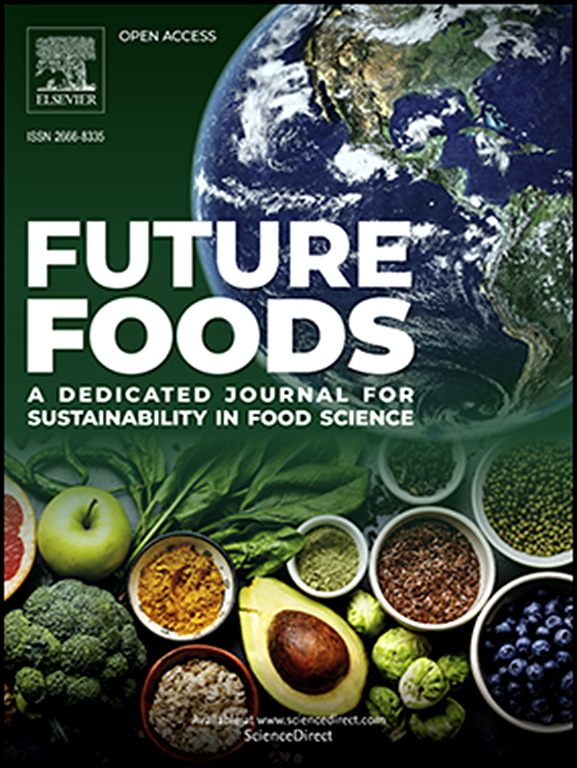Synergistic potential of agrobiomass-derived xylooligosaccharides (XOS) and antioxidants as pioneering prebiotics for probiotic cultivation
IF 8.2
Q1 FOOD SCIENCE & TECHNOLOGY
引用次数: 0
Abstract
Prebiotic resources, such as xylooligosaccharides (XOS), which are resistant to acidity and temperature, can be derived from lignocellulosic agrobiomass. Hydrolysates containing prebiotic XOS were produced from fruit, rice, and sugarcane biomass using acid and hydrothermal pretreatments. Phosphoric acid pretreatment showed greater potential for biomass breakdown and oligosaccharide release. FTIR analysis detected xylan and pectin in the pellets produced by precipitating the hydrolysates of mango peel (MP), pineapple peel (PP), rice bran (RB) and sugarcane leaf (SCL). The hydrolysate and the precipitate presented different XOS (xylobiose and xylotetraose) profiles and were more than twofold greater in the PP, RB, and SCL pellets (71.28, 109.55, and 188.48 mg/mL, respectively) than in the MP pellets (0.29 mg/mL). SCL hydrolysate, as a carbon source, promotes probiotic growth but is unsuitable for pathogen growth. Furthermore, fermenting the spray-dried SCL hydrolysate powder with probiotics (Bacillus subtilis and lactic acid bacteria) significantly increased its phenolic (236.07 µg GAE/mL) and flavonoid (2.75 mg QE/mL) contents and antioxidant activity (75.77 %). This study highlights the potential for a synergistic interaction between XOS and bioactive compounds, which may considerably benefit probiotics and their hosts. This research demonstrates an efficient and straightforward method for producing XOS, yielding prebiotics at 189.72 g/kg of biomass. This approach provides a viable alternative for the development of plant-based, value-added food products.

农业生物质衍生的低聚木糖(XOS)和抗氧化剂作为益生菌培养的先驱益生元的协同潜力
益生元资源,如低聚木糖(XOS),其耐酸性和温度,可以从木质纤维素农业生物质中提取。利用酸和水热预处理从水果、水稻和甘蔗生物质中生产出含有益生元XOS的水解产物。磷酸预处理对生物质分解和低聚糖释放具有较大的潜力。FTIR分析检测了芒果皮(MP)、菠萝皮(PP)、米糠(RB)和甘蔗叶(SCL)水解产物沉淀生产的球团中木聚糖和果胶的含量。水解产物和沉淀物的XOS(木糖二糖和木糖四糖)分布不同,PP、RB和SCL微球的XOS分别为71.28、109.55和188.48 mg/mL,是MP微球的两倍多(0.29 mg/mL)。SCL水解液作为碳源,对益生菌生长有促进作用,但不利于病原菌生长。此外,用益生菌(枯草芽孢杆菌和乳酸菌)发酵喷雾干燥的SCL水解液粉末,其酚(236.07µg GAE/mL)和类黄酮(2.75 mg QE/mL)含量和抗氧化活性显著提高(75.77%)。这项研究强调了XOS和生物活性化合物之间潜在的协同相互作用,这可能大大有利于益生菌及其宿主。本研究展示了一种高效、直接的生产XOS的方法,产量为189.72 g/kg生物质。这种方法为开发植物性增值食品提供了一种可行的替代方案。
本文章由计算机程序翻译,如有差异,请以英文原文为准。
求助全文
约1分钟内获得全文
求助全文
来源期刊

Future Foods
Agricultural and Biological Sciences-Food Science
CiteScore
8.60
自引率
0.00%
发文量
97
审稿时长
15 weeks
期刊介绍:
Future Foods is a specialized journal that is dedicated to tackling the challenges posed by climate change and the need for sustainability in the realm of food production. The journal recognizes the imperative to transform current food manufacturing and consumption practices to meet the dietary needs of a burgeoning global population while simultaneously curbing environmental degradation.
The mission of Future Foods is to disseminate research that aligns with the goal of fostering the development of innovative technologies and alternative food sources to establish more sustainable food systems. The journal is committed to publishing high-quality, peer-reviewed articles that contribute to the advancement of sustainable food practices.
Abstracting and indexing:
Scopus
Directory of Open Access Journals (DOAJ)
Emerging Sources Citation Index (ESCI)
SCImago Journal Rank (SJR)
SNIP
 求助内容:
求助内容: 应助结果提醒方式:
应助结果提醒方式:


